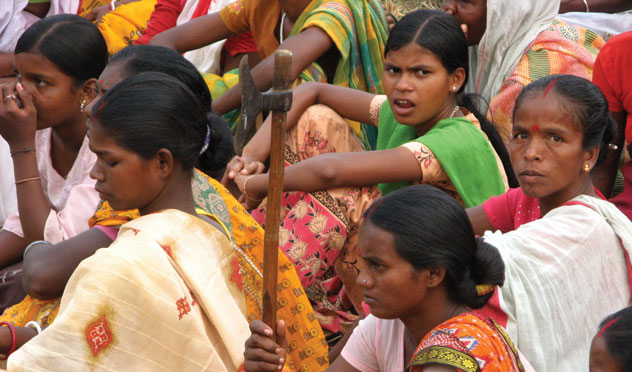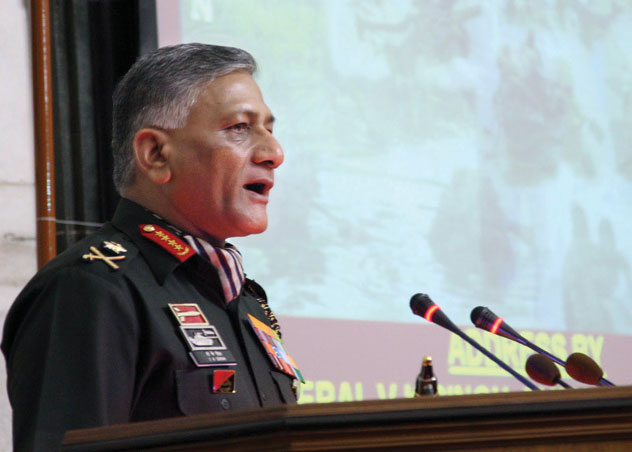POLITICS:
Strategic Retreat: Less Force Against Maoists
The Army has a role in preventing external aggression or in assisting in humanitarian crisis. But beyond that, in India, the army does not have a role. The failure of New Delhi to curb retaliatory Leftist violence over the last few years has the Army chief thinking, writes Siddharth Srivastava.

(Above): Disgruntled tribal women, one seen with an axe.
There has been some debate in India about involving the Army to flush out Maoist insurgents that infest large areas of Eastern and Central India. Dealing with the leftist rebels is seen as India’s biggest internal security challenge.
In a reflection of establishment thinking, Indian Army Chief General V.K. Singh has ruled out deployment of armed forces for direct action on the armed rebels. “When the Naxalite issue was presented to us, we were very clear in our minds that it is a socio-economic problem, a problem created by bad governance,” he said last month.
The General said: “Army is not the answer (to Naxal problem). Army has a role in preventing external aggression. Army has a role in assisting in humanitarian crisis. But beyond that, in our country, at least the way the Army has come up, we do not think that we have a role.”
Singh’s statements clearly indicate a strategic retreat in the tackling of the Maoist issue has emerged due to failure of New Delhi to curb retaliatory Leftist violence due to increased use of state forces over the last few years.
It also means that the government will follow a two-pronged strategy of using state and paramilitary forces to flush out the armed rebels, while humanitarian and political efforts will look to diminish the numbers that take up arms.
Over the recent past, questions were raised about New Delhi’s approach of using sheer force against the Maoists.
The actions were based on an earlier federal home ministry assessment that “the Naxalites are bent on violence and mayhem against the state and the people and there is need for the government to squarely meet the threat.”
Defense forces have been deployed in India’s “Red Corridor” areas for logistical support, even as New Delhi has been toying with the idea of more active use of the military, including use of drones or unmanned aerial vehicles procured from America and Israel to pinpoint and further decimate specific targets.
New Delhi has sought advice from U.S. counter-insurgency personnel involved in fighting the Taliban and jihadis in Afghanistan and Pakistan’s tribal areas.
However, critics say that a more political and humane approach should focus on economic and social development of the deprived population.
New Delhi has been criticized for equating Maoists with terrorists as the rebels mostly attack symbols of state power (property and personnel) and not soft targets or civilians, as is the case of jihadi terrorists who aim at any human loss such as the repeated attacks in Mumbai and other cities of India.
In June 2009, New Delhi labeled the Naxalite group, the Communist Party of India (Maoist), or CPI (M), a terrorist organization, putting it in the same league as other banned outfits such as Pakistan’s Lashkar-e-Toiba which is accused of carrying out some of the most lethal attacks in India, including 26/11, Mumbai.

(Above): File photo of Indian Army Chief General V.K. Singh, seen here addressing a gathering. [Photo: Ministry of Defense]
A military strategy against the Maoist is also seen as infeasible as they are spread across vast swathes of India’s mineral-rich states making it near impossible to defeat solely by force and require strong intelligence and guerilla tactics to flush out. The U.S. military and its allies have not been able to defeat the Taliban in Afghanistan. As in that country, the Maoists have strong grassroots support.
Repeated strikes by leftist rebels continue to pose a big challenge to New Delhi. 1,169 people died last year, the most in any year since the armed rebellion began nearly four and a half decades ago.
Nearly 15,000 people, including police, rebels and civilians, have been killed in the violence so far. The Maoists believe in armed struggle to overthrow the state and bring about socio-economic changes, predominantly in the states of Jharkhand, Chhattisgarh and Orissa, Bihar, Madhya Pradesh, West Bengal and Andhra Pradesh.
India’s valuable coal and mineral industry is focused in these states, which have large tribal concentrations. The areas score very poorly on human development as the local population has not benefited from rich mining activities that have instead filled state coffers, politicians, the bureaucracy and a few “outsider” businessmen.
A link has thus been established between the Maoist insurgency and rapacious mining in forested areas and the exploitation of the local inhabitants.
Tribals constitute more than 8 percent of the country’s population but account for 40 percent of the 50-60 million internally displaced since India’s independence in 1947 due to land diversion, especially due to coal mining.
Maoists rebels are very well armed, with weapons mostly obtain acquired by raiding police and paramilitary posts and smuggling from Nepal, Burma and China.
Clearly, New Delhi has its task cut out.
|